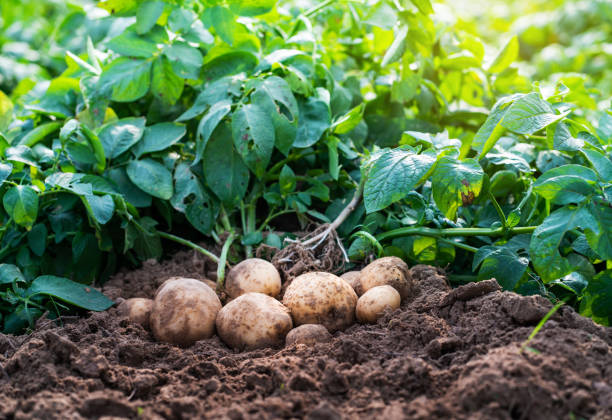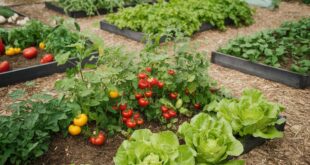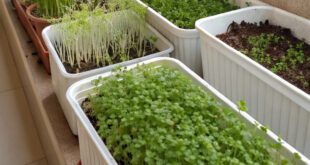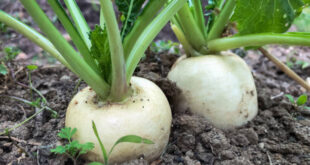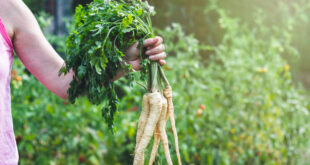Potatoes are one of the most profitable crops to grow at home. They are versatile in the kitchen, easy to cultivate and produce a bountiful harvest.
Whether you're growing them in the garden, raised bed or container, this guide will walk you through every step of the process, from selecting seed potatoes to storing your harvest so you can enjoy it for months.
Why grow potatoes?
Potatoes are a staple in many diets and are rich in carbohydrates, vitamins and minerals. Homegrown potatoes have unmatched freshness and flavor compared to store-bought potatoes.
Plus, they're relatively easy to grow, making them perfect for both beginners and experienced gardeners. Growing your own potatoes is also cost-effective, as a small investment in seed potatoes can result in a large harvest.
Potatoes are highly adaptable and can be grown in various climates, making them an essential crop in any garden.
Step 1: Choose your potato variety
Different types of potatoes have unique flavors, textures and uses. Here are some common types to consider:
- Reddish brown potatoes: Due to their loose consistency, they are ideal for baking and frying.
- Yukon Gold: Ideal for frying, pureeing and cooking, with a creamy texture and buttery taste.
- Red potatoes: Perfect for salads, cooking and steaming as they hold their shape well.
- Fingerling potatoes: Known for their buttery flavor, unique elongated shape and suitability for roasting.
- Purple potatoes: An eye-catcher thanks to their bright color and full of antioxidants, ideal for frying and steaming.
When choosing a variety, consider your cooking preferences and storage needs. For example, russets are great for long-term storage, while new potatoes like Red Bliss are best enjoyed fresh.
Step 2: Select and prepare seed potatoes
Potatoes are grown from “seed potatoes,” which are certified disease-free tubers. How to prepare them:
- Buy seed potatoes: Buy from a trusted garden center or supplier to ensure they are disease-free and of high quality.
- Cut larger potatoes: If the seed potatoes are large, cut them into smaller pieces, making sure each piece has at least one “eye” or sprout. Allow the cut pieces to dry for 1-2 days to form a protective layer and prevent rot.
- Pre-germination (optional): Before planting, place seed potatoes in a cool, bright location to encourage germination. This is particularly useful in areas with short growing seasons.
Step 3: Prepare the planting site
Soil requirements
- Potatoes prefer loose, well-drained soil rich in organic matter to promote healthy root and tuber development.
- The soil pH should be slightly acidic, between 5.0 and 6.5, to prevent diseases such as scab.
Location
- Choose a sunny location with at least 6-8 hours of direct sunlight daily. Potatoes thrive in full sun, which promotes vigorous growth and tuber production.
Soil preparation
- Loosen the soil to a depth of 30 cm to allow the roots to grow freely and the tubers to expand.
- Mix in compost or well-rotted manure to improve fertility and soil structure.
- Remove weeds and debris to create a clean planting area, as competition can stunt potato growth.
Step 4: Plant the potatoes
- Timing: Plant potatoes in early spring, 2-4 weeks before the last frost date, when the soil temperature is at least 7°C.
- Create trenches: Dig trenches about 15 to 20 cm deep and space them 30 to 45 cm apart. These trenches help retain moisture and make hilling easier later.
- Placing seed potatoes: Place the seed potatoes in the trench with the “eyes” facing up. Space them 10-12 inches apart to ensure they have enough room to grow.
- Cover with soil: Lightly cover the potatoes with 3-4 inches of soil. Avoid completely filling the trench at this time; You will add more soil as the plants grow.
Step 5: Care for Potato Growing
irrigation
- Always keep the soil moist but not waterlogged to prevent the tubers from bursting or rotting.
- Potatoes require about 1 to 2 inches of water per week. During dry periods, increase irrigation to keep the soil evenly moist.
- Avoid overhead watering to minimize the risk of fungal diseases.
Hilling
- When the plants reach 6 to 8 inches (15 to 20 cm.) in height, mound soil around the base of the plants to cover the lower stems and developing tubers. This process, called “hilling,” prevents the tubers from being exposed to sunlight, which can cause them to turn green and poisonous.
- Repeat hilling every 2-3 weeks, adding soil until the hill is about 30cm high. Hilling also helps support the plants and improve drainage.
Fertilize
- Use a balanced, low-nitrogen fertilizer to promote tuber development. Too much nitrogen promotes leaf growth at the expense of tubers.
- Apply fertilizer once at planting and again mid-season to increase yield.
Pest and disease management
- Colorado potato beetle: Hand-pick beetles and larvae or use organic pesticides like neem oil.
- Plague: Choose disease-resistant varieties, practice crop rotation, and avoid overhead irrigation to reduce the risk of this fungal disease.
- Wireworms: Rotate crops and avoid planting potatoes in the same spot every year to minimize pest populations.
Step 6: Harvest potatoes
New potatoes
- Harvest young “early potatoes” 2-3 weeks after the plants have flowered. These small, tender tubers are perfect for steaming or cooking.
- Using your hands or a trowel, carefully dig around the base of the plant to remove the new potatoes without disturbing the main crop.
Ripe potatoes
- Wait until the foliage turns yellow and dies back, usually 10-12 weeks after planting, before harvesting mature potatoes.
- Gently lift the plants with a garden fork, starting at the edge, to avoid damaging the tubers.
- Allow the potatoes to cure in a cool, dark, dry place for 1-2 weeks. This process strengthens your skin and improves its durability.
Step 7: Store potatoes
- Short-term storage: Store fresh potatoes in a cool, dark, well-ventilated place. Avoid storing them in the refrigerator as cold temperatures can convert the starch into sugar, affecting the flavor.
- Long-term storage: Store dried potatoes in a root cellar or similar location at 4-10°C (40-50°F) with high humidity to prevent drying out.
- Check regularly: Inspect stored potatoes for signs of rot, sprouting or shrinkage. Remove affected tubers to prevent spoilage.
Additional tips for success
- Crop rotation: Avoid planting potatoes in the same spot every year to reduce the risk of pests and diseases.
- Companion planting: Grow potatoes alongside beans, corn or marigolds to deter pests and improve soil health.
- Gardening in Containers: If space is limited, grow potatoes in large containers or grow bags. Provide proper drainage and follow the same planting and care guidelines.
- Extend the season: Use mulch or row covers to protect plants from late frosts and extend the growing season.
- Experiment with varieties: Grow multiple varieties of potatoes to enjoy different flavors, colors and textures.
Growing potatoes at home is a fun and rewarding experience.
By following these detailed steps, you'll enjoy a delicious harvest of fresh, flavorful potatoes that pair perfectly with any dish. Have fun gardening!
Unlock the Secrets to Thriving Potato Plants: Your Ultimate Step-by-Step Guide!
Are you looking to cultivate healthy and bountiful potato plants in your garden? From choosing the right variety to providing proper care and harvesting techniques, this comprehensive guide will unlock the secrets to thriving potato plants. Follow these step-by-step instructions and watch your potato plants flourish!
Choosing the Right Variety:
When it comes to growing potatoes, choosing the right variety is key. There are numerous types of potatoes available, each with its own unique characteristics. Some popular varieties include Yukon Gold, Russet, and Red Pontiac. Consider factors like taste preference, cooking method, and space availability in your garden when selecting a variety.
Preparing the Soil:
Potatoes thrive in loose, well-draining soil with a pH level between 5.8 and 6.5. Before planting, amend the soil with organic matter like compost or aged manure to improve its structure and fertility. Remove any rocks or debris from the soil to ensure healthy root growth.
Planting Potatoes:
Potatoes can be planted in early spring, once the soil temperature reaches around 45-50°F. Cut seed potatoes into pieces with at least two eyes each and allow them to cure for a few days before planting. Plant the seed pieces in rows, spacing them about 12 inches apart and covering them with a few inches of soil.
Watering and Fertilizing:
Potato plants require consistent moisture throughout the growing season. Water regularly, especially during dry periods, to prevent the soil from drying out. Fertilize the plants with a balanced fertilizer high in potassium to promote healthy tuber development.
Hilling and Mulching:
As potato plants grow, they will benefit from hilling – the process of mounding soil around the base of the plants to protect emerging tubers from sunlight. Mulch can also be applied around the plants to help retain moisture, suppress weeds, and regulate soil temperature.
Pest and Disease Control:
Keep a close eye on your potato plants for signs of pests and diseases, such as potato beetles and late blight. Implement preventive measures like crop rotation, companion planting, and the use of organic pesticides to protect your plants from harm.
Harvesting Potatoes:
Potatoes are ready to harvest when the plant foliage starts to yellow and die back. Use a garden fork to gently dig up the tubers, being careful not to damage them. Allow the harvested potatoes to cure for a few days in a cool, dark place before storing them for long-term use.
Benefits and Practical Tips:
- Growing your own potatoes allows you to enjoy fresh, flavorful tubers free from harmful chemicals.
- Rotate your potato crop yearly to prevent soil-borne diseases and maintain soil health.
- Consider planting early, mid-season, and late-season varieties for a staggered harvest throughout the season.
- Store harvested potatoes in a cool, dark, and well-ventilated place to prevent sprouting and spoilage.
Firsthand Experience:
“I’ve been growing potatoes in my garden for years, and it’s always a rewarding experience. By following these simple steps and providing proper care, I’ve been able to harvest a bountiful supply of fresh, delicious potatoes each season. There’s nothing quite like the satisfaction of digging up your own homegrown spuds!”
growing thriving potato plants is a rewarding and enjoyable endeavor for any gardener. By following the tips and techniques outlined in this guide, you can cultivate healthy potato plants and enjoy a bountiful harvest of delicious tubers. So, roll up your sleeves, grab your gardening gloves, and start unlocking the secrets to thriving potato plants today!
 redboth.com Decoration ideas for your home
redboth.com Decoration ideas for your home
